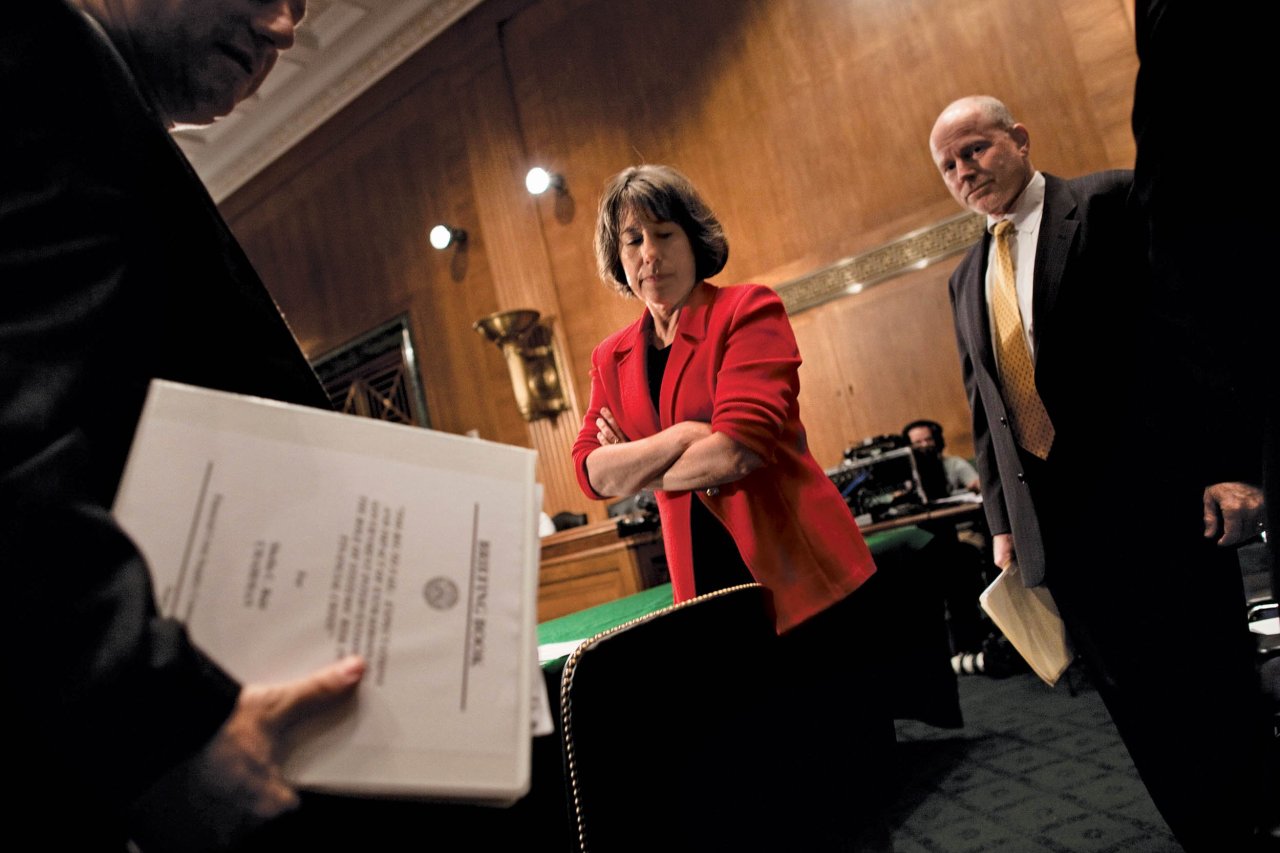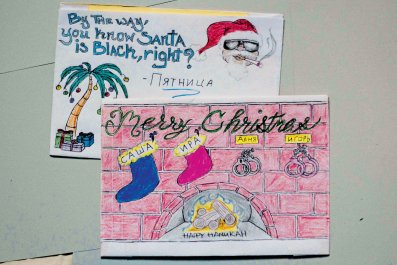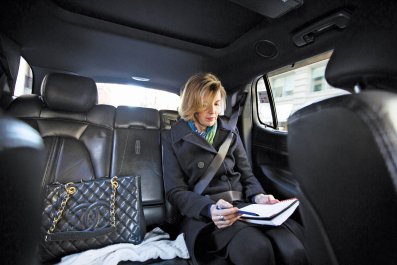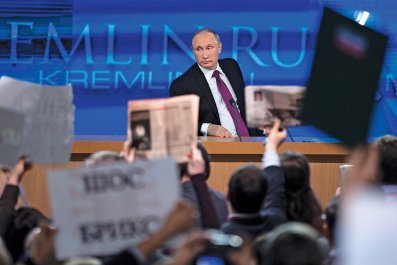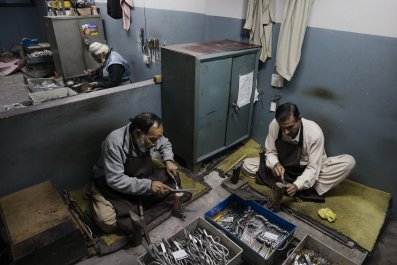In spring 2009, a bank examiner inside the Federal Reserve Bank of New York called colleagues with worrisome news: Yet another crisis was brewing for Citigroup, the global banking giant that despite taking more than $476 billion in bailout cash and guarantees, the most of any rescued bank, was near collapse.
That financially tumultuous spring, Citigroup wasn't just another casualty in the fallout of the 2007–2008 mortgage meltdown. With around $1.9 trillion in assets, it was so woven into the fabric of American and global financial life, and so infested with soured mortgage-related loans and derivatives, that Federal Reserve Chairman Ben Bernanke had six months earlier deemed the behemoth too big to fail, later telling a government bailout inspector that it was "not even a close call to assist them."
Now the problem, the New York Fed bank examiner told colleagues, was that another regulator, the Federal Deposit Insurance Corporation, planned to lower a critical rating it held on the precarious financial health of Citibank, the main banking subsidiary of Citigroup.
Lowering the rating, then-FDIC Chair Sheila Bair wrote in her 2012 book Bull by the Horns, would have delivered a gunshot to Citibank by putting it on the FDIC's very public list of problem bank assets. (While the list does not name banks, assets as large as Citibank's would have been easily identifiable.)
It would also have done something else previously unreported, former New York Fed sources tell Newsweek. It would have forced the New York Fed to restrict Citi's ability to take part in the routine money shuffle banks need for basic operations: temporarily overdrawing their Federal Reserve accounts each day by hundreds of billions of dollars as payments from around the globe clear at different hours, then topping off the accounts by day's end.
Amid the biggest financial crisis since the Great Depression, not being able to participate in that money shuffle, known as "daylight overdraft credit," would have sent Citibank scrambling to the Fed's beggar's window, a facility known as the "discount window." Even in ordinary times, banks don't like using that alternative because it signals to investors and trading partners that a bank is in trouble. In a crisis, it can easily send a troubled bank's investors, shareholders and trading partners running.
Citibank, long a bellwether stock, never showed up on the FDIC's "problem bank assets" list—on May 26, 2009, Bair wrote, she got a call from Bernanke "asking that the FDIC not downgrade." But downgrade or not, Citigroup had a liquidity problem on the horizon, and the quality of their assets was questionable, according to the two former New York Fed sources. So in mid-2009, these two sources say, the New York Fed quietly made an unusual, previously unreported deal with Citigroup.
The New York Fed would allow Citibank to continue to overdraw that all-important "daylight overdraft" account, although at reduced levels. In a companion, also atypical move, the New York Fed forced Citigroup to park some $30 billion in collateral, consisting of Treasury bills and soured derivatives whose value Fed officials discounted, in a Federal Reserve account as insurance that the bank would eventually square things in its overdraft account. The move was risky, one of the Fed sources adds: "If word got out on this, Citibank's counterparties might flee, squeezing the entity further with liquidity pressure."
Through the behind-the-scenes maneuver, the New York Fed gained something as well, one of the former officers says: a failing bank that looked better than it was and thus a regulator that appeared in control of the crisis.
The conventional wisdom about the New York Fed, which oversees Wall Street banks, is that the 2008 crisis cast a harsh light on how often the agency is in bed with the banks it oversees, a money-world condition known as "regulatory capture." The fresh part of that phenomenon, underscored by the previously unreported solution the New York Fed devised for Citigroup, is that the Fed had an interest not just in making the banks it regulates look good but in making itself look good. With Citigroup, one of the former New York Fed sources said, "People were going to say, 'Why didn't you uncover this earlier?' It's an admission of failure." Added the second source: "We're the ones who are supposed to know the real-world impact, and it looked like we didn't."
"Citi was in much more serious trouble than people outside" both the bank and the New York Fed knew, "and the Fed wanted to keep that out of the public eye," says Janet Tavakoli, a derivatives expert based in Chicago. "It needed to say that Citi, and the banking system, were healthier than they really were, so that their authority to regulate them didn't get stripped away."
It's not known whether the New York Fed allowed similar breaks for other troubled banks, or when Citi's unusual collateral arrangement ended. Asked about the issue, Andrea Priest, a spokeswoman for the New York Fed, wrote in an email, "Sorry, we don't comment on confidential supervisory information."
Told of the overdraft privilege, Nancy Bush, a bank analyst, tells Newsweek, "I would think that this is an indication that things were way worse than even we knew."
Asked about the special arrangement, Mark Costiglio, a Citigroup spokesman, declined to comment.
The backdoor deal appears to have helped keep Citigroup, now America's third-largest bank in terms of assets, out of the grave. Since the mortgage meltdown, it has managed to grow earnings and shed some toxic assets even though it continues to struggle with probes into its role in manipulating foreign currencies. But Citigroup has also ramped up its dealings in derivatives, a complex, risky bet that fueled the credit crisis during the 2008 collapse; the company had some $62 trillion in such contracts as of end-June 2014, up from $37 trillion in June 2009, according to data from the Office of the Comptroller of the Currency, another regulator.
The Federal Reserve is under increasing scrutiny from whistle-blowers, critics and Congress over assertions that its cozy ties with Wall Street, particularly at the all-important New York branch, prevent it from regulating big banks and stifle debate and dissent. Seven years after the crisis began, that culture hasn't changed, say former Fed officers and some critics of the institution. The New York branch "is arrogant to the point of a lack of self-awareness," says one of the former senior officers, who is now back on Wall Street.
The main Federal Reserve, to which the branch nominally answers, can appear to be on a different planet. Bernanke was not aware that his all-important New York branch had downgraded Citigroup's CAMELS Rating when he asked Bair not to do the same, Bair said. (The Fed rating is not as significant to a bank's operations as the FDIC rating.) To this day, argues Lou Crandall, chief economist at Wrightson ICAP LLC, an advisory firm in Jersey City, New Jersey, the New York Fed "culture is to make banks safe, which means you may not have an enforcement culture."
This can also lead to inconsistency. The first former New York Fed officer said that the unusual collateral arrangement risked creating "the appearance that we were not applying special arrangements equally across the board." After all, the Fed had allowed Lehman Brothers to go bankrupt just eight months earlier. "Lehman just wasn't a good member of the old boys club," the source says.
By all accounts, the New York Fed was deeply worried about Citigroup. The rating at issue in May 2009, CAMELS—which stands for Capital adequacy, Asset quality, Management, Earnings, and Liquidity and a bank's Sensitivity to market risk—is perhaps the single most important factor in driving the capital banks access. A "1" means solid, while a "5" means you're about to go belly up, if not already being scooped out of the tank. Bair wanted to downgrade Citibank from a less-than-satisfactory 3 to a 'yikes' 4, the New York Fed bank examiner told colleagues, according to the two sources.
Around the time of the examiner's May 2009 conversation with colleagues, the Fed said publicly that Citigroup could potentially lose as much as $104.7 billion by 2010, a sum that would nearly wipe out the amount of assets Citigroup held against losses, a key metric known as tier-one capital. Only six months earlier, in November 2008, the Fed, through the New York branch, had guaranteed $301 billion of Citigroup's troubled assets, a move that suggested people at the highest levels of the New York Fed (and by extension the Federal Reserve) grasped how bad Citigroup's problems were.
Only they didn't. Worse, the Fed wasn't even aware that it didn't know, according to the two former senior New York Fed officers, who were in different departments but each close to the issue. The branch, the two former officers say, was "very unaware of the extreme degradation" of certain Citi assets the Fed had guaranteed six months earlier, complex derivatives backed by soured mortgages known as a collateralized debt obligations.
Even as New York Fed staffers dubbed Citi "Shitty," according to one of the former New York Fed officers, the competency and credibility of the New York Fed's handling of Citigroup was already under question. Take a little-noticed critique of the branch, buried in the 2011 Financial Crisis Inquiry Commission report, a 633-page autopsy of the crisis, by its peers in Chicago, St. Louis, Kansas City and elsewhere. The critique, a December 2009 "Operations Review Report" of the New York Fed's Bank Supervision Group, focused on the group's supervision of Citigroup over 2004 through 2008, when the bank was building up massive positions in risky mortgage-backed assets that would soon tank. The report trashed the New York Fed, saying the supervision group for Citigroup had been "less than effective"—the same finding of a similar review in May 2005. "The team has not been proactive in making changes to the regulatory ratings of the firm," the 2009 report said, adding that Citigroup examiners "lacked the appropriate level of focus on" Citigroup's "risk oversight and internal audit functions."
Peter Wallison, a financial policy expert at the American Enterprise Institute, a conservative think tank, argues that because the Federal Reserve is both a regulator of Wall Street banks (through the New York branch) and a conductor of monetary policy (funneled through the New York branch), it has an incentive to make those regulated banks appear solid, even when they're not. Letting outsiders know that a special cookie jar was needed to keep Citigroup alive could have sent destabilizing signals to the market.
Why should people care now? Because Citigroup is still trying to get rid of hundreds of billions of dollars in toxic assets, in large part through a planned initial public offering of OneMain Financial Holdings Inc., a core piece of the "bad bank" Citigroup set up in early 2009 to house what was initially a whopping $875 billion in sketchy consumer loans.
The New York Fed "wants to continue to have the banks look profitable because that is something they as regulators got some psychic reward for," Wallison says. "Their main incentive is to ensure the economy is growing—even if the banks are making that happen in a dangerous way."



